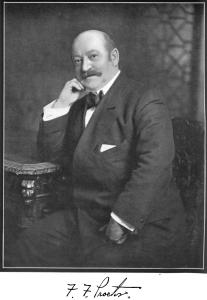 On Friday, Sept. 7, locals were able to learn more about both the personal and professional life of vaudeville impresario F.F. Proctor — full name is Frederick Freeman Proctor — who is known for developing the original Proctors in Schenectady back in 1912.
On Friday, Sept. 7, locals were able to learn more about both the personal and professional life of vaudeville impresario F.F. Proctor — full name is Frederick Freeman Proctor — who is known for developing the original Proctors in Schenectady back in 1912.
The event was titled “Proctor: A Man, His Theater, Our Heritage” and was part of the Coffee and Conversation series at the Bethlehem Public Library, which is co-sponsored by Bethlehem Senior Projects, Inc.
The series takes place every Friday through Nov. 16, starting at 1 p.m. with visiting speakers and musicians talking about their craft, followed by an hour of complimentary coffee and light snacks at 2 p.m.
Marilyn Sassi — a long-time museum curator, and adjunct professor at both Hudson Valley Community College and Schenectady County Community College — did her research before presentation that Friday, hoping to educate the audience about the theater’s origins, since it has been a significant landmark in the Capital District.
While providing a slideshow of vivid historical photographs of Proctor himself who lived from Mar. 7, 1851 to Sept. 4, 1929 as well as the theater’s appearance through the decades, she also spoke about how the man grew from being an acrobatic performer himself to achieving his dream of opening his own theater.
A self-professed theater lover, Sassi personally volunteers at Proctors where she has served as a tour guide for 13 years now. She recounted how she first watched movies at the theater with her grandfather when she was around five years old. Eventually, she became fascinated with Proctor’s life as well as how throughout the 20th century, his theater was developed, maintained, almost demolished and renovated for the modern times.
To gather her research, Sassi worked with historians at the Schenectady County Historical Society, a historian near Central Valley as well as Proctor’s closest living relative, his great-grandnephew, who supplied exclusive information and photographs.
She discussed how Proctor himself was a professional acrobat and performed in vaudeville houses in the late 19th century, calling himself “F.F. Levantine.” Gaining a desire at age 29 to buy and manage a theater though, “the only thing he can afford was a rundown, really shabby theater down on Green Street in Albany called the Gaiety at the time,” she said.
Eventually, he oversaw the openings of more theaters nationwide and in 1925, the aforementioned Albany theater was moved to its present location in Schenectady. Sassi noted that the introduction of television, shopping malls and World War II factored into the theater’s downfall eventually, as well as Proctor’s own death in 1929.
Falling into particular disrepair by the 1960s and 1970s, the theater was almost demolished but was saved when the Schenectady Council of the Arts intervened and money was raised via grants to begin renovations. It officially reopened on Jan. 3, 1979. Since then, the theater has undergone further renovations and maintenance in an effort to return it to its former aesthetic glory from the early 20th century.
“Now, when you go into the theater, you are walking into what people would have seen when the theater first opened,” Sassi concluded her presentation, resulting in sheer applause from the mostly-packed audience.
The next Coffee and Conversation event is this Friday, Sept. 14 at 1 p.m.
This article was originally published by The Spot 518.


Comments are closed.